Returns of irregular migrants - quarterly statistics
Data extracted on 10 June 2024
Planned article update: September 2024
Highlights
103 515 non-EU citizens were ordered to leave the territory of an EU country in the first quarter of 2024, a decrease of 7.1% compared with the same period of 2023.
In the first quarter of 2024, 30 570 non-EU citizens who received an order to leave an EU country were returned to another country, an increase of 11.4 % compared with the same period of 2023.
Third-country nationals ordered to leave and third-country nationals returned following an order to leave, EU, Q1 2022 - Q1 2024
This article presents two indicators on the enforcement of immigration legislation. It shows statistics on non-EU citizens who were ordered to leave the territory of an EU country[1] and those who were effectively returned following an order to leave. These indicators can be regarded as an official record of persons subject to the enforcement of EU immigration and national legislation, providing a general overview of the outcomes of territorial surveillance and control procedures.
Full article
Non-EU citizens ordered to leave
In the first quarter of 2024, the total number of non-EU citizens ordered to leave the territory of an EU country was 103 515 (Table 1). This represents a decrease in comparison with the previous quarter (-2.0%) or with the same period of 2023 (-7.1%).
Among the EU countries, France reported the largest number of persons ordered to leave (34 190), followed by Germany (15 400) and Belgium (6 965). These three EU countries altogether accounted for more than half (56 555 persons) of all third-country nationals ordered to leave during the first quarter of 2024.
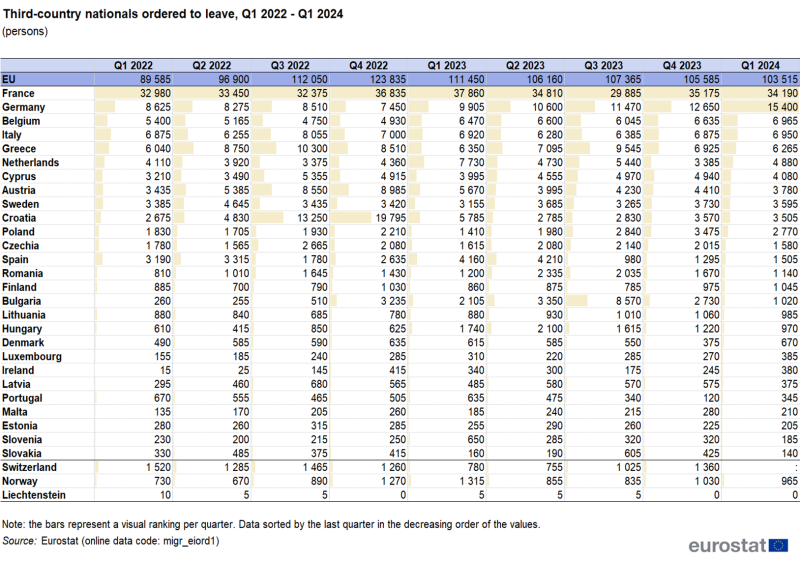
(persons)
Source: Eurostat (migr_eiord1)
The top five citizenships of third-country nationals ordered to leave in Q1 2024 (Figure 1) were Algerian (7 670), followed by Moroccan (7 170), Turkish (6 545), Syrian (5 400) and Georgian (5 165).Regarding the trends for these top five non-EU citizenships , citizens of Türkiye (0.7%) and Algeria (0.1%) recorded a slight increase in the number of persons for whom orders to leave an EU country were issued compared with the previous quarter (Q4 2024). By contrast, Morocco (-12.9%), Syria (-7.9%) and Georgia (-7.7%)recorded a decrease in the number of persons for whom orders to leave EU countries were issued.
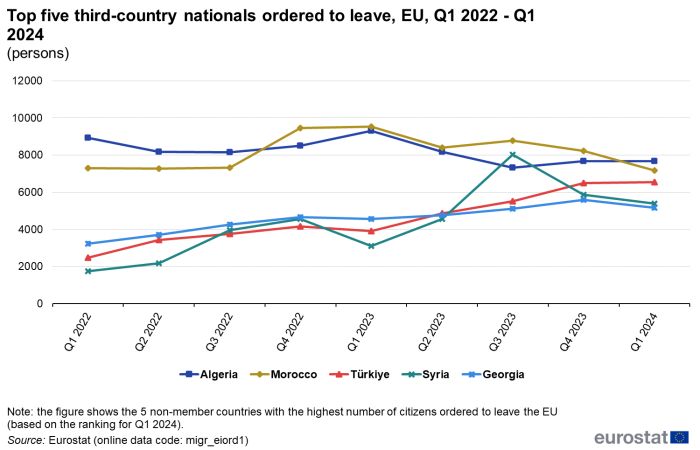
(persons)
Source: Eurostat (migr_eiord1)
The number of orders to leave issued in Q1 2024 compared with Q1 2023 significantly increased for Syrians (73.5%), Turks (68.1%) and Georgians (13.2%), while decreases were observed for Moroccans (-24.7%) and Algerians (-17.5%).
Returns of non-EU citizens
In the first quarter of 2024, 30 570 non-EU citizens who received an order to leave an EU country were effectively returned to another country. This represented an increase of 11.4 % compared with the same quarter of 2023 (Table 2). France (4 205), Germany (3 950) and Sweden (3 135) reported the highest numbers of third-country nationals returned in the first quarter of 2024, accounting for more than one third of the total number of returns (36.9 %).
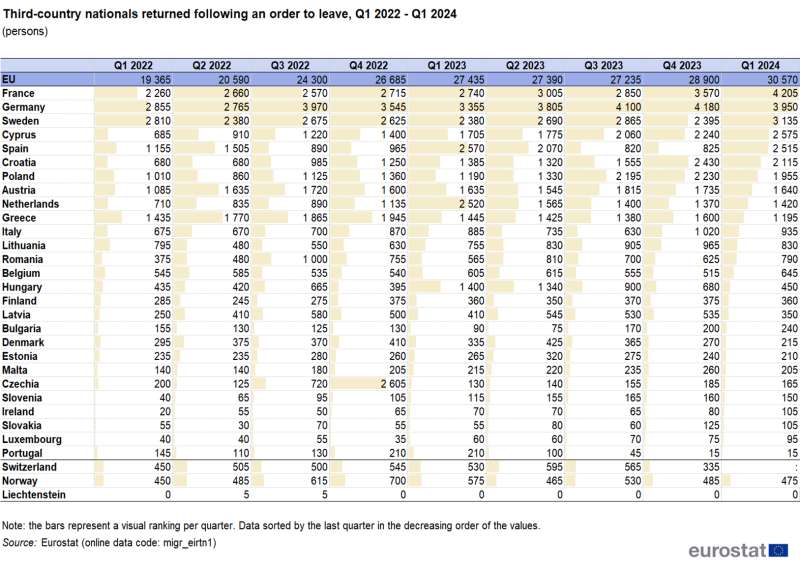
(persons)
Source: Eurostat (migr_eirtn1)
Georgians (2 625) were the top non-EU citizenship returned to another country in the first quarter of 2024 (Figure 2), followed by Albanians (1 855), Turks (1 800), Colombians (1 305) and Moroccans (1 290).
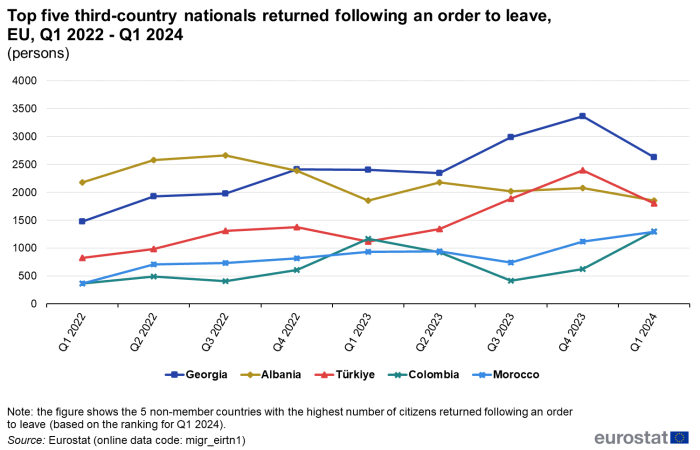
(persons)
Source: Eurostat (migr_eirtn1)
Compared with the previous quarter (Q4 2023), the number of citizens of Georgia (21.9%), Albania (11.0%) and Türkiye (24.9%) returned to another country decreased, while the number of Colombians (108.8%) and Moroccans (15.5%) returned to other countries increased.
When comparing Q1 2024 with Q1 2023, the number of returns increased for Turks (60.8%), Moroccans (37.7%), Colombians (11.2%) and Georgians (9.3%), while for Albanians the figures were stable.
Types of returns and assistance received
Based on the available data, the returns at EU level show that 48.2% of returns concerned people who left the territory voluntarily, while 51.8% concerned those returned forcibly (Figure 3). In Germany, Italy and Portugal all the returns reported were enforced while in Latvia, Lithuania and Denmark more than 90% of reported returns were recorded as voluntary.
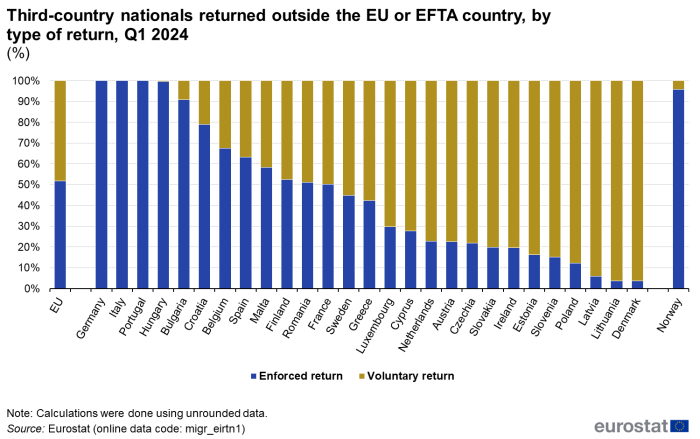
(%)
Source: Eurostat (migr_eirtn1)
To facilitate the return of non-EU citizens, assisted return programmes funded by the EU, national or international organisations may provide reintegration support for returnees. This may include administrative, logistical and/or financial support to migrants who return to their country of origin.
In the first quarter of 2024, across the EU countries for which data are available, 75.7 % of returns were assisted and 24.3 % were non-assisted (Figure 4). In Cyprus, Germany, Spain, Italy and Portugal all non-EU citizens were assisted in their return, while almost all third-country nationals leaving Latvia and Lithuania were not assisted.
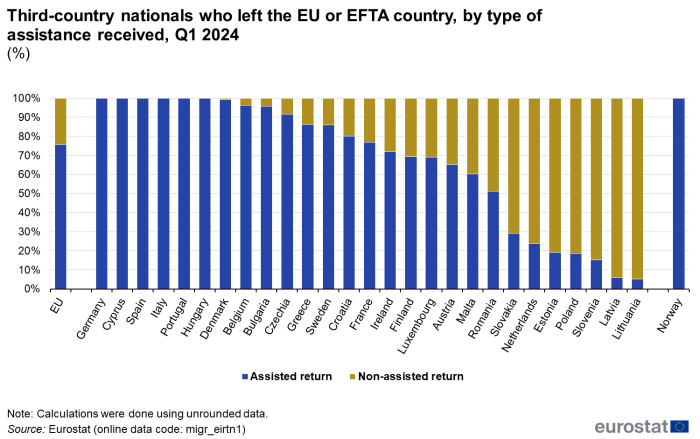
(%)
Source: Eurostat (migr_eirtn1)
Unaccompanied minors ordered to leave the EU and those returned following an order to leave
An unaccompanied minor is a person who is less than 18 years old who arrives on the territory of an EU country not accompanied by an adult responsible for the minor or a minor who is left unaccompanied after having entered the territory of a Member State.
In the first quarter of 2024 were issued 590 orders to leave EU territory to unaccompanied minors, a decrease (-9.0%) when comparing with fourth quarter of 2023, and an increase of 44.0% in comparison with the first quarter of 2023. Greece (400), followed by Croatia (80) and the Netherlands (45) issued the most orders to unaccompanied minors to leave EU territory (Figure 5). About two-thirds of the unaccompanied minors ordered to leave were from Egypt (185), Afghanistan (125) and Syria (90).
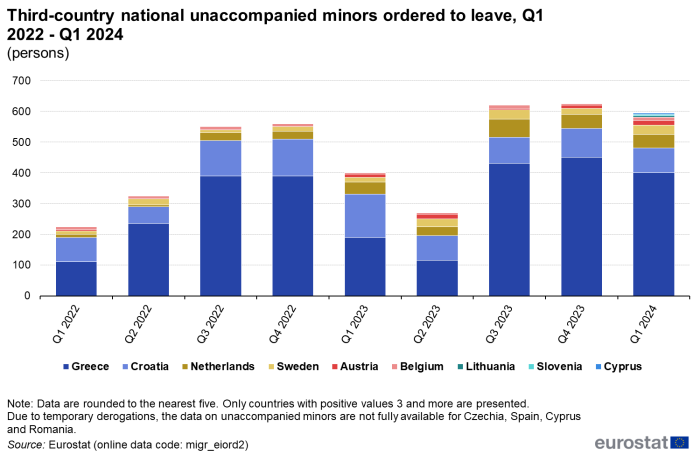
(persons)
Source: Eurostat (migr_eiord2)
In the first quarter of 2024, based on the available data, 105 unaccompanied minors who received an order to leave an EU country were returned to another country. Germany (60), Croatia (20), Sweden, Lithuania and Austria (5 each) reported the highest number of unaccompanied minors returned following an order to leave their territory. The unaccompanied minors returned were mainly from Syria (25), Guinea (20) Algeria and Côte d'Ivoire (10).
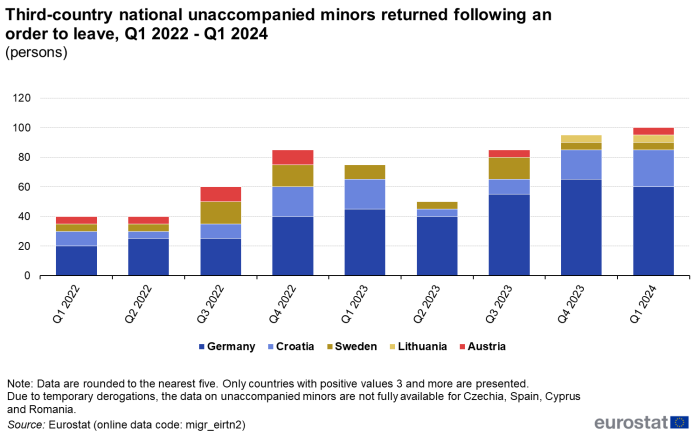
Q1 2022 - Q1 2024
(persons)
Source: Eurostat (migr_eirtn2)
Source data for tables and graphs
Data sources
Statistics on the enforcement of immigration legislation are based on administrative data provided by national authorities in line with the requirements of Regulation (EC) No 862/2007 concerning statistics on migration and international protection. The compilation of these statistics draws on the terms used by the Schengen Borders Code, an EU code on the rules governing the movement of persons across borders (Regulation (EU) No 2016/399); for more information on the Schengen area, see here.
The amendment to Regulation (EC) No 862/2007 adopted in June 2020 led to certain improvements. It increased the frequency, timeliness and the level of detail of the statistics from reference year 2021, including new information on unaccompanied minors who represent a particularly vulnerable group. The new statistics are continuously published in the Eurostat database and are presented in this article.
Statistics on the enforcement of immigration legislation exclude outgoing asylum seekers who are transferred from one Member State to another under the mechanism established by the Dublin Regulation (Regulation (EC) No 1560/2003 and Regulation (EU) No 604/2013); these cases are covered by Dublin statistics.
Note that the data presented in this article are rounded to the nearest five. Due to the rounding, various totals (such as for the EU) may not necessarily match the sum of the values for their components (such as the sum of values for the EU countries).
Data on unaccompanied minors ordered to leave and returned following an order to leave are not available for Portugal. Due to temporary derogations, the data on unaccompanied minors for both collections are not fully available for Czechia, Spain, Cyprus, the Netherlands and Romania. As a result, these EU countries were not included in the calculation of the respective EU totals.
In relation to the statistics presented in this article the following derogations were granted to Member States based on Commission Implementing Decision (EU) 2021/431 of 10 March 2021:
1) For the data on Persons returned following an order to leave:
- Transmission of the disaggregations by the assistance received
- Czechia for the reference years 2021-2023
- Transmission of the disaggregations by the type of return and assistance received
- Lithuania for the reference year 2021
- Cyprus and Sweden for the reference years 2021-2023
2) For the data on Persons ordered to leave and Persons returned following an order to leave:
- Transmission of the disaggregation by unaccompanied minors
- Belgium, Lithuania and Portugal for the reference year 2021
- Czechia, Spain, Cyprus, the Netherlands and Romania for the reference years 2021-2023
Note that due to differences in national administrative procedures in migration law enforcement and methodological aspects related to compilation of data in this area, the number of persons returned in a given quarter shall not be directly related with the number of persons ordered to leave in the same reference period, e.g. a person can be ordered to leave in Q4 of year N, but effectively returned in Q1 of year N+1.
Context
The enforcement of migration law refers to two main subjects: controlling the EU's external borders and the management of unauthorised non-EU citizens found on the territory of an EU country. Control of the EU's external borders constitutes one of the pillars for the creation of a freedom, security and justice area. The most noteworthy developments concern a harmonised set of rules governing the movement of persons across borders (the Schengen Borders Code published by Regulation (EU) No 2016/399); a comprehensive approach for European integrated management at the EU's border and efficient and effective management of border crossing and EU returns policy, respecting fundamental rights, and safeguarding free movement, operated by the European Border and Coast Guard Agency (Regulation (EU) No 2019/1896); an extensive package on automated border control was introduced (namely the Entry-Exit System established by (namely the Entry-Exist System established by the Regulation (EU) No 2017/2225 and Regulation (EU) No 2017/2226, and the European Traveler Information and Authorisation System established by Regulation (EU) No 2018/1240 and Regulation (EU) No 2018/1241).
The management of irregular migrant populations involves the finding of illegally present persons, the recognition of a decision of an order to leave and the effective return. The main legal instrument, the so-called Return Directive (Return Directive (2008/115/EC)), came into force at the end of 2010 establishing common standards for returning non-EU citizens illegally staying in the EU. The EU also aims to promote a more effective return system (Policy Document Towards an Operational Strategy for more Effective Returns - COM/2023/45 Final), aimed at achieving, as an operational goal, among others, the improvement of data and statistical evidence-based on return, building a more targeted, planned and efficient return policy, and a common operational response capability.
Several Schengen Area member countries have temporarily reintroduced the border control at internal borders pursuant to Article 25 and 28 et seq. of the Schengen Borders Code (with several reasons, for instance significant high pressure of irregular migration flows, smuggling and trafficking of human beings, secondary movements; organised criminal and terrorism threats; relevant events that could enhance migration flows and or criminal or terrorism threats) (Member States’ notifications of the temporary reintroduction of border control at internal borders).
Regarding measuring the enforcement of immigration legislation, progress made so far on collecting harmonised data results from the adoption of Regulation (EC) No 862/2007, in particular Articles 5 and 7. Regulation (EC) No 2020/851 amended Regulation (EC) No 862/2007, aimed at, among other commitments, establishing a framework for a quick response to changing needs regarding statistics on migration and international protection. It also commits to data collection on a sub-annual basis in order to respond to the main needs for study, formulation and evaluation of migration and developing human-rights-based policies, and enhancing the knowledge of migration and international protection and migratory movements within European Union countries.
The New Pact on Migration and Asylum was published on 22/05/2024, 22/05/2024, and an impact on the return policy and corresponding figures can be expected.
Notes
- ↑ Statistics on the enforcement of immigration legislation refer to the concept of external borders for all EU countries and EFTA countries, even if some of these are not in the Schengen area. The external borders of the Schengen area do not coincide with the external borders of the EU countries due to: opt-outs for Ireland from the Schengen area; Bulgaria, Cyprus are not yet member of the Schengen area; Bulgaria and Romania are Schengen area members since 31 March of 2024, but maintaining the border control on land borders; Iceland, Liechtenstein, Norway and Switzerland are part of the Schengen area but are not members of the EU.
Direct access to
- All articles on managed migration
- Enforcement of immigration legislation statistics introduced
- Annual asylum application statistics
- Asylum applications - monthly statistics
- Asylum quarterly report
- Statistics on countries responsible for asylum applications (Dublin Regulation)
- Residence permits
- Enforcement of Immigration Legislation (migr_eil)
- Third country nationals refused entry at the external borders - annual data (rounded) (migr_eirfs)
- Third country nationals found to be illegally present - annual data (rounded) (migr_eipre)
- Third country nationals ordered to leave - annual data (rounded) (migr_eiord)
- Third country nationals ordered to leave by citizenship, age and sex - quarterly data (rounded) (migr_eiord1)
- Third-country unaccompanied minors ordered to leave, by citizenship, age and sex of the minor – quarterly data (rounded) (migr_eiord2)
- Third country nationals returned following an order to leave - annual data (rounded) (migr_eirtn)
- Third-country nationals returned following an order to leave, by type of return, citizenship, country of destination, age and and sex – quarterly data (migr_eirtn1)
- Third-country unaccompanied minors returned following an order to leave, by type of return, citizenship, country of destination, age and sex of the minor – quarterly data (rounded) (migr_eirtn2)
- Third-country nationals who have left the territory by type of return and citizenship (migr_eirt_vol)
- Third-country nationals who have left the territory by type of assistance received and citizenship (migr_eirt_ass)
- Third-country nationals who have left the territory to a third country by type of agreement procedure and citizenship (migr_eirt_agr)
- Third-country nationals who have left the territory to a third country by destination country and citizenship (migr_eirt_des)
- Returns by type of return - % of total returns (migr_eilretpc)
- Persons subject to immigration law enforcement - per thousand persons (migr_eilpop)
- Enforcement of Immigration Legislation (ESMS metadata file — migr_eil_esms)
- Communication COM(2004) 412 final of 4 June 2004: Study on the links between legal and illegal migration
- Communication (COM(2018) 250 final of 14 March 2018: Progress report on the Implementation of the European Agenda on Migration
- Directive2008/115/EC on common standards and procedures in Member States for returning illegally staying third-country nationals
- Policy Document Towards an operational strategy for more effective returns (COM/2023/45 final)
- Regulation (EC) No 862/2007 on Community statistics on migration and international protection (Articles 5 and 7)
- Regulation (EU) 2020/851 of the European Parliament and of the Council of 18 June 2020 amending Regulation (EC) No 862/2007 on Community statistics on migration and international protection
- Regulation (EU) 2019/1896 of the European Parliament and of the Council of 13 November 2019 on the European Border and Coast Guard and repealing Regulations (EU) No 1052/2013 (EUROSUR) and (EU) 2016/1624 (European Border and Coast Guard)
- Regulation (EU) 2016/399 of the European Parliament and of the Council of 9 March 2016 on a Union Code on the rules governing the movement of persons across borders (Schengen Borders Code)
- Regulation (EU) 2017/2225 of the European Parliament and of the Council of 30 November 2017 amending Regulation (EU) 2016/399 as regards the use of the Entry/Exit System
- Regulation (EU) 2017/2226 of the European Parliament and of the Council of 30 November 2017 establishing an Entry/Exit System (EES) to register entry and exit data and refusal of entry data of third-country nationals crossing the external borders of the Member States and determining the conditions for access to the EES for law enforcement purposes, and amending the Convention implementing the Schengen Agreement and Regulations (EC) No 767/2008 and (EU) No 1077/2011
- Regulation (EU) 2018/1240 of the European Parliament and of the Council of 12 September 2018 establishing a European Travel Information and Authorisation System (ETIAS) and amending Regulations (EU) No 1077/2011, (EU) No 515/2014, (EU) 2016/399, (EU) 2016/1624 and (EU) 2017/2226
- Regulation (EU) 2018/1241 of the European Parliament and of the Council of 12 September 2018 amending Regulation (EU) 2016/794 for the purpose of establishing a European Travel Information and Authorisation System (ETIAS)
- Regulation (EU) 2018/1860 of the European Parliament and of the Council of 28 November 2018 on the use of the Schengen Information System for the return of illegally staying third-country nationals
- Regulation (EU) 2018/1861 of the European Parliament and of the Council of 28 November 2018 on the establishment, operation and use of the Schengen Information System (SIS) in the field of border checks, and amending the Convention implementing the Schengen Agreement, and amending and repealing Regulation (EC) No 1987/2006
- Regulation (EU) 2018/1862 of the European Parliament and of the Council of 28 November 2018 on the establishment, operation and use of the Schengen Information System (SIS) in the field of police cooperation and judicial cooperation in criminal matters, amending and repealing Council Decision 2007/533/JHA, and repealing Regulation (EC) No 1986/2006 of the European Parliament and of the Council and Commission Decision 2010/261/EU
New Pact on Migration and Asylum of the EU
- Pact on Migration and Asylum of the EU
- Regulation (EU) 2024/1347 of the European Parliament and of the Council of 14 May 2024 on standards for the qualification of third-country nationals or stateless persons as beneficiaries of international protection, for a uniform status for refugees or for persons eligible for subsidiary protection and for the content of the protection granted, amending Council Directive 2003/109/EC and repealing Directive 2011/95/EU of the European Parliament and of the Council
- Regulation (EU) 2024/1348 of the European Parliament and of the Council of 14 May 2024 establishing a common procedure for international protection in the Union and repealing Directive 2013/32/EU
- Regulation (EU) 2024/1349 of the European Parliament and of the Council of 14 May 2024 establishing a return border procedure, and amending Regulation (EU) 2021/1148
- Regulation (EU) 2024/1350 of the European Parliament and of the Council of 14 May 2024 establishing a Union Resettlement and Humanitarian Admission Framework, and amending Regulation (EU) 2021/1147
- Regulation (EU) 2024/1351 of the European Parliament and of the Council of 14 May 2024 on asylum and migration management, amending Regulations (EU) 2021/1147 and (EU) 2021/1060 and repealing Regulation (EU) No 604/2013
- Regulation (EU) 2024/1352 of the European Parliament and of the Council of 14 May 2024 amending Regulations (EU) 2019/816 and (EU) 2019/818 for the purpose of introducing the screening of third-country nationals at the external borders
- Regulation (EU) 2024/1356 of the European Parliament and of the Council of 14 May 2024 introducing the screening of third-country nationals at the external borders and amending Regulations (EC) No 767/2008, (EU) 2017/2226, (EU) 2018/1240 and (EU) 2019/817
- Regulation (EU) 2024/1358 of the European Parliament and of the Council of 14 May 2024 on the establishment of ‘Eurodac’ for the comparison of biometric data in order to effectively apply Regulations (EU) 2024/1351 and (EU) 2024/1350 of the European Parliament and of the Council and Council Directive 2001/55/EC and to identify illegally staying third-country nationals and stateless persons and on requests for the comparison with Eurodac data by Member States’ law enforcement authorities and Europol for law enforcement purposes, amending Regulations (EU) 2018/1240 and (EU) 2019/818 of the European Parliament and of the Council and repealing Regulation (EU) No 603/2013 of the European Parliament and of the Council
- Regulation (EU) 2024/1359 of the European Parliament and of the Council of 14 May 2024 addressing situations of crisis and force majeure in the field of migration and asylum and amending Regulation (EU) 2021/1147
- Directive (EU) 2024/1346 of the European Parliament and of the Council of 14 May 2024 laying down standards for the reception of applicants for international protection